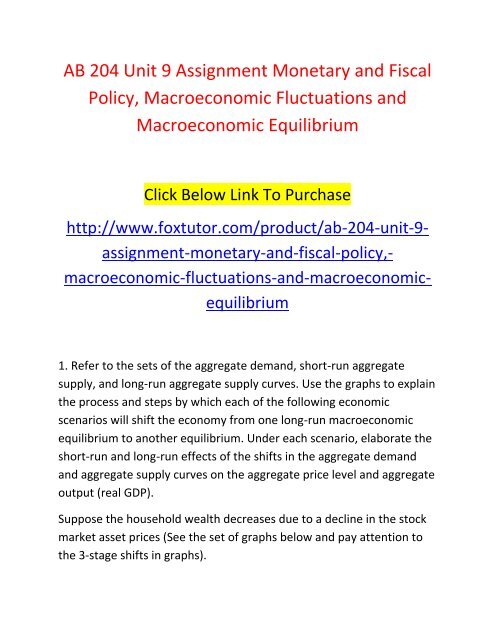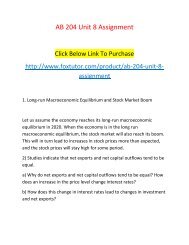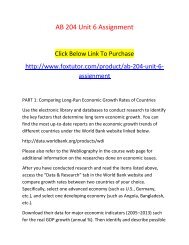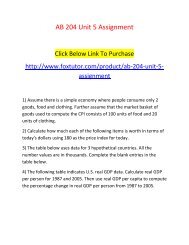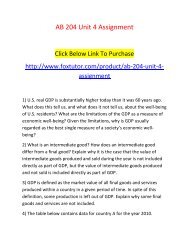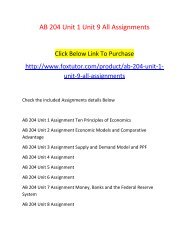AB 204 Unit 9 Assignment Monetary and Fiscal Policy, Macroeconomic Fluctuations and Macroeconomic Equilibrium
AB 204 Unit 9 Assignment Monetary and Fiscal Policy, Macroeconomic Fluctuations and Macroeconomic Equilibrium Click Below Link To Purchase http://www.foxtutor.com/product/ab-204-unit-9- assignment-monetary-and-fiscal-policy,- macroeconomic-fluctuations-and-macroeconomicequilibrium 1. Refer to the sets of the aggregate demand, short-run aggregate supply, and long-run aggregate supply curves. Use the graphs to explain the process and steps by which each of the following economic scenarios will shift the economy from one long-run macroeconomic equilibrium to another equilibrium. Under each scenario, elaborate the short-run and long-run effects of the shifts in the aggregate demand and aggregate supply curves on the aggregate price level and aggregate output (real GDP). Suppose the household wealth decreases due to a decline in the stock market asset prices (See the set of graphs below and pay attention to the 3-stage shifts in graphs). Assume the government lowers taxes, which increases the household’s disposable income. However, the government purchases (spending) remains the same. (See the set of graphs below and shifts in graphs) 2. Suppose the economy of a hypothetical country has reached its longrun macroeconomic equilibrium when each of the following aggregate demand shocks occurs. What kind of gap, inflationary or recessionary gap, will the economy face after the AD shock indicated by the shift in AD curves? What types of fiscal policy instruments will help move the economy back to the potential level of output (real GDP)? Give specific examples. At the long-run macroeconomic equilibrium, the stock market boom occurs and this increases the value of stocks households hold. (See the set of graphs below and shifts in graphs in the two-steps) The government increases its purchases (spending) due to natural disasters. (See the set of graphs below and shifts in graphs) Assume the Central Bank reduces the money supply in the economy which leads to an increase in the interest rates. (See the set of graphs below and shifts in graphs)
AB 204 Unit 9 Assignment Monetary and Fiscal
Policy, Macroeconomic Fluctuations and
Macroeconomic Equilibrium
Click Below Link To Purchase
http://www.foxtutor.com/product/ab-204-unit-9-
assignment-monetary-and-fiscal-policy,-
macroeconomic-fluctuations-and-macroeconomicequilibrium
1. Refer to the sets of the aggregate demand, short-run aggregate
supply, and long-run aggregate supply curves. Use the graphs to explain
the process and steps by which each of the following economic
scenarios will shift the economy from one long-run macroeconomic
equilibrium to another equilibrium. Under each scenario, elaborate the
short-run and long-run effects of the shifts in the aggregate demand
and aggregate supply curves on the aggregate price level and aggregate
output (real GDP).
Suppose the household wealth decreases due to a decline in the stock
market asset prices (See the set of graphs below and pay attention to
the 3-stage shifts in graphs).
Assume the government lowers taxes, which increases the household’s
disposable income. However, the government purchases (spending)
remains the same. (See the set of graphs below and shifts in graphs)
2. Suppose the economy of a hypothetical country has reached its longrun
macroeconomic equilibrium when each of the following aggregate
demand shocks occurs. What kind of gap, inflationary or recessionary
gap, will the economy face after the AD shock indicated by the shift in
AD curves? What types of fiscal policy instruments will help move the
economy back to the potential level of output (real GDP)? Give specific
examples.
At the long-run macroeconomic equilibrium, the stock market boom
occurs and this increases the value of stocks households hold. (See the
set of graphs below and shifts in graphs in the two-steps)
The government increases its purchases (spending) due to natural
disasters. (See the set of graphs below and shifts in graphs)
Assume the Central Bank reduces the money supply in the economy
which leads to an increase in the interest rates. (See the set of graphs
below and shifts in graphs)
You also want an ePaper? Increase the reach of your titles
YUMPU automatically turns print PDFs into web optimized ePapers that Google loves.
<strong>AB</strong> <strong>204</strong> <strong>Unit</strong> 9 <strong>Assignment</strong> <strong>Monetary</strong> <strong>and</strong> <strong>Fiscal</strong><br />
<strong>Policy</strong>, <strong>Macroeconomic</strong> <strong>Fluctuations</strong> <strong>and</strong><br />
<strong>Macroeconomic</strong> <strong>Equilibrium</strong><br />
Click Below Link To Purchase<br />
http://www.foxtutor.com/product/ab-<strong>204</strong>-unit-9-<br />
assignment-monetary-<strong>and</strong>-fiscal-policy,-<br />
macroeconomic-fluctuations-<strong>and</strong>-macroeconomicequilibrium<br />
1. Refer to the sets of the aggregate dem<strong>and</strong>, short-run aggregate<br />
supply, <strong>and</strong> long-run aggregate supply curves. Use the graphs to explain<br />
the process <strong>and</strong> steps by which each of the following economic<br />
scenarios will shift the economy from one long-run macroeconomic<br />
equilibrium to another equilibrium. Under each scenario, elaborate the<br />
short-run <strong>and</strong> long-run effects of the shifts in the aggregate dem<strong>and</strong><br />
<strong>and</strong> aggregate supply curves on the aggregate price level <strong>and</strong> aggregate<br />
output (real GDP).<br />
Suppose the household wealth decreases due to a decline in the stock<br />
market asset prices (See the set of graphs below <strong>and</strong> pay attention to<br />
the 3-stage shifts in graphs).
Assume the government lowers taxes, which increases the household’s<br />
disposable income. However, the government purchases (spending)<br />
remains the same. (See the set of graphs below <strong>and</strong> shifts in graphs)<br />
2. Suppose the economy of a hypothetical country has reached its longrun<br />
macroeconomic equilibrium when each of the following aggregate<br />
dem<strong>and</strong> shocks occurs. What kind of gap, inflationary or recessionary<br />
gap, will the economy face after the AD shock indicated by the shift in<br />
AD curves? What types of fiscal policy instruments will help move the<br />
economy back to the potential level of output (real GDP)? Give specific<br />
examples.<br />
At the long-run macroeconomic equilibrium, the stock market boom<br />
occurs <strong>and</strong> this increases the value of stocks households hold. (See the<br />
set of graphs below <strong>and</strong> shifts in graphs in the two-steps)<br />
The government increases its purchases (spending) due to natural<br />
disasters. (See the set of graphs below <strong>and</strong> shifts in graphs)<br />
Assume the Central Bank reduces the money supply in the economy<br />
which leads to an increase in the interest rates. (See the set of graphs<br />
below <strong>and</strong> shifts in graphs)


